Saint Patrick's Day
| Saint Patrick's Day | |
|---|---|
 Saint Patrick depicted in a stained glass window at Saint Benin's Church, Ireland | |
| Official name | Saint Patrick's Day |
| Also called | |
| Observed by |
|
| Type | Ethnic, national, Christian |
| Significance |
Feast day of Saint Patrick, commemoration of the arrival of Christianity in Ireland[3] |
| Celebrations |
|
| Observances | Attending mass or service |
| Date | 17 March |
| Next time | 17 March 2016 |
| Frequency | Annual |
Saint Patrick's Day, or the Feast of Saint Patrick (Irish: Lá Fhéile Pádraig, "the Day of the Festival of Patrick"), is a cultural and religious celebration held on 17 March, the traditional death date of Saint Patrick (c. AD 385–461), the foremost patron saint of Ireland.
Saint Patrick's Day was made an official Christian feast day in the early 17th century and is observed by the Catholic Church, the Anglican Communion (especially the Church of Ireland),[4] the Eastern Orthodox Church, and Lutheran Church. The day commemorates Saint Patrick and the arrival of Christianity in Ireland,[3] and celebrates the heritage and culture of the Irish in general.[5] Celebrations generally involve public parades and festivals, céilithe, and the wearing of green attire or shamrocks.[6] Christians also attend church services[5][7] and the Lenten restrictions on eating and drinking alcohol are lifted for the day, which has encouraged and propagated the holiday's tradition of alcohol consumption.[5][6][8][9]
Saint Patrick's Day is a public holiday in the Republic of Ireland,[10] Northern Ireland,[11] the Canadian province of Newfoundland and Labrador, and the British Overseas Territory of Montserrat. It is also widely celebrated by the Irish diaspora around the world, especially in Great Britain, Canada, the United States, Argentina, Australia, and New Zealand.
Saint Patrick
Patrick was a 5th-century Romano-British Christian missionary and bishop in Ireland. Much of what is known about Saint Patrick comes from the Declaration, which was allegedly written by Patrick himself. It is believed that he was born in Roman Britain in the fourth century, into a wealthy Romano-British family. His father was a deacon and his grandfather was a priest in the Christian church. According to the Declaration, at the age of sixteen, he was kidnapped by Irish raiders and taken as a slave to Gaelic Ireland.[12] It says that he spent six years there working as a shepherd and that during this time he "found God". The Declaration says that God told Patrick to flee to the coast, where a ship would be waiting to take him home. After making his way home, Patrick went on to become a priest.
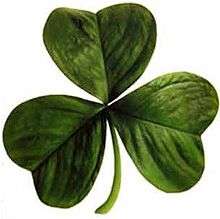
According to tradition, Patrick returned to Ireland to convert the pagan Irish to Christianity. The Declaration says that he spent many years evangelising in the northern half of Ireland and converted "thousands". Patrick's efforts to convert, subjugate, and drive off the Pagans (specifically the Celts) were eventually turned into an allegory in which he drove "snakes" out of Ireland. (Ireland never had any snakes.)
Tradition holds that he died on 17 March and was buried at Downpatrick. Over the following centuries, many legends grew up around Patrick and he became Ireland's foremost saint.
Celebration and traditions
Wearing of the green
On St Patrick's Day it is customary to wear shamrocks and/or green clothing or accessories (the "wearing of the green"). St Patrick is said to have used the shamrock, a three-leaved plant, to explain the Holy Trinity to the pagan Irish.[13][14] This story first appears in writing in 1726, though it may be older.
In pagan Ireland, three was a significant number and the Irish had many triple deities, a fact that may have aided St Patrick in his evangelisation efforts.[15][16] Patricia Monaghan says there is no evidence that the shamrock was sacred to the pagan Irish.[15] However, Jack Santino speculates that it may have represented the regenerative powers of nature, and was recast in a Christian context—icons of St Patrick often depict the saint "with a cross in one hand and a sprig of shamrocks in the other".[17] Roger Homan writes, "We can perhaps see St Patrick drawing upon the visual concept of the triskele when he uses the shamrock to explain the Trinity".[18]
The colour green has been associated with Ireland since at least the 1640s, when the green harp flag was used by the Irish Catholic Confederation. Green ribbons and shamrocks have been worn on St Patrick's Day since at least the 1680s.[19] The Friendly Brothers of St Patrick, an Irish fraternity founded in about 1750,[20] adopted green as its colour.[21] However, when the Order of St. Patrick—an Anglo-Irish chivalric order—was founded in 1783 it adopted blue as its colour, which led to blue being associated with St Patrick. During the 1790s, green would become associated with Irish nationalism, due to its use by the United Irishmen. This was a republican organisation—led mostly by Protestants but with many Catholic members—who launched a rebellion in 1798 against British rule. The phrase "wearing of the green" comes from a song of the same name, which laments United Irishmen supporters being persecuted for wearing green. Throughout the 19th and 20th centuries, the colour green and its association with St Patrick's Day grew.[22]
The wearing of the 'St Patrick's Day Cross' was also a popular custom in Ireland until the early 20th century. These were a Celtic Christian cross made of paper that was "covered with silk or ribbon of different colours, and a bunch or rosette of green silk in the centre".[23]
Celebrations by region
Ireland
Saint Patrick's feast day, as a kind of national day, was already being celebrated by the Irish in Europe in the ninth and tenth centuries. In later times, he became more and more widely known as the patron of Ireland.[24] Saint Patrick's feast day was finally placed on the universal liturgical calendar in the Catholic Church due to the influence of Waterford-born Franciscan scholar Luke Wadding[25] in the early 1600s. Saint Patrick's Day thus became a holy day of obligation for Roman Catholics in Ireland. It is also a feast day in the Church of Ireland. The church calendar avoids the observance of saints' feasts during certain solemnities, moving the saint's day to a time outside those periods. St Patrick's Day is occasionally affected by this requirement, when 17 March falls during Holy Week. This happened in 1940, when Saint Patrick's Day was observed on 3 April to avoid it coinciding with Palm Sunday, and again in 2008, where it was officially observed on 14 March. St Patrick's Day will not fall within Holy Week again until 2160.[26][27] However, the secular celebration is always held on 17 March.
In 1903, St Patrick's Day became an official public holiday in Ireland. This was thanks to the Bank Holiday (Ireland) Act 1903, an act of the United Kingdom Parliament introduced by Irish Member of Parliament James O'Mara.[28] O'Mara later introduced the law that required that pubs and bars be closed on 17 March after drinking got out of hand, a provision that was repealed in the 1970s.
The first St Patrick's Day parade in Ireland was held in Waterford in 1903. The week of March 15–22, 1903 had been declared Irish Language Week by the Gaelic League and in Waterford they opted to have a procession on Sunday March 15. The Waterford trades unions from the Trades Hall decided to take part in this “St Patrick’s Day Procession”.[29] The procession comprised the Mayor and members of Waterford Corporation, the Trades Hall, the various trade unions and bands who included the Barrack St. Band and the Thomas Francis Meagher Band. This procession started from the premises of the Gaelic League in George's St. and finished in the Peoples Park, Waterford where the public were addressed by the Mayor and other dignitaries.[30][31] On Tuesday, March 17 Waterford business premises were closed and marching bands paraded like they did two days previously.[32] The Waterford Trades Hall had been emphatic that the National Holiday be observed and it appears that most business premises remained closed for March 17, including a lot of Public Houses. > [30]
The first St Patrick's Day parade in Dublin took place in 1931 and was reviewed by the then Minister of Defence Desmond Fitzgerald.
In the mid-1990s the government of the Republic of Ireland began a campaign to use St Patrick's Day to showcase Ireland and its culture.[33] The government set up a group called St Patrick's Festival, with the aims:

- To offer a national festival that ranks amongst all of the greatest celebration in the world
- To create energy and excitement throughout Ireland via innovation, creativity, grassroots involvement, and marketing activity
- To provide the opportunity and motivation for people of Irish descent (and those who sometimes wish they were Irish) to attend and join in the imaginative and expressive celebrations
- To project, internationally, an accurate image of Ireland as a creative, professional and sophisticated country with wide appeal.[34]
.jpg)
The first St Patrick's Festival was held on 17 March 1996. In 1997, it became a three-day event, and by 2000 it was a four-day event. By 2006, the festival was five days long; more than 675,000 people attended the 2009 parade. Overall 2009's five-day festival saw close to 1 million visitors, who took part in festivities that included concerts, outdoor theatre performances, and fireworks.[35] Skyfest forms the centrepiece of the festival.
The topic of the 2004 St Patrick's Symposium was "Talking Irish", during which the nature of Irish identity, economic success, and the future were discussed. Since 1996, there has been a greater emphasis on celebrating and projecting a fluid and inclusive notion of "Irishness" rather than an identity based around traditional religious or ethnic allegiance. The week around St Patrick's Day usually involves Irish language speakers using more Irish during Seachtain na Gaeilge ("Irish Language Week").
Christian leaders in Ireland have expressed concern about the secularisation of St Patrick's Day. In The Word magazine's March 2007 issue, Fr. Vincent Twomey wrote, "It is time to reclaim St Patrick's Day as a church festival." He questioned the need for "mindless alcohol-fuelled revelry" and concluded that "it is time to bring the piety and the fun together."[36]
As well as Dublin, many other cities, towns, and villages in Ireland hold their own parades and festivals, including Cork, Belfast, Derry, Galway, Kilkenny, Limerick, and Waterford.
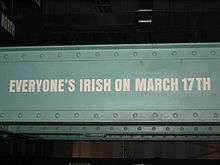
The biggest celebrations outside Dublin are in Downpatrick, County Down, where Saint Patrick is rumoured to be buried. The shortest St Patrick's Day parade in the world takes place in Dripsey, Cork. The parade lasts just 100 yards and travels between the village's two pubs.[37]
Argentina

In Buenos Aires, a party is held in the downtown street of Reconquista, where there are several Irish pubs;[38][39] in 2006, there were 50,000 people in this street and the pubs nearby.[40] Neither the Catholic Church nor the Irish community, the fifth largest in the world outside Ireland,[41] take part in the organisation of the parties.
Canada
Montreal Saint Patrick's Day Parade (c. 1824)
One of the longest-running and largest St Patrick's Day parades in North America occurs each year in Montreal,[42] whose city flag includes a shamrock in its lower-right quadrant. The annual celebration has been organised by the United Irish Societies of Montreal since 1929. The parade has been held annually without interruption since 1824. St. Patrick's Day itself, however, has been celebrated in Montreal since as far back as 1759 by Irish soldiers in the Montreal Garrison following the British conquest of New France.

Manitoba Saint Patrick's Day Festival
In Manitoba, the Irish Association of Manitoba runs an annual three-day festival of music and culture based around St Patrick's Day.[43]
Vancouver CelticFest (c. 2004)
In 2004, the CelticFest Vancouver Society organised its first annual festival in downtown Vancouver to celebrate the Celtic Nations and their culture. This event, which includes a parade, occurs each year during the weekend closest to St Patrick's Day.[44]
Quebec Saint Patrick's Day Parade (1837-1926 and 2010-)
In Quebec City, there was a parade from 1837 to 1926. The Quebec City St-Patrick Parade returned in 2010 after an absence of more than 84 years. For the occasion, a portion of the New York Police Department Pipes and Drums were present as special guests.
Toronto Saint Patrick's Day Parade (c. 1863)
There has been a parade held in Toronto since at least 1863.[45] The Toronto Maple Leafs hockey team was known as the Toronto St. Patricks from 1919 to 1927, and wore green jerseys. In 1999, when the Maple Leafs played on Saint Patrick's Day, they wore green Saint Patrick's retro uniforms. There is a large parade in the city's downtown core on the Sunday prior to 17 March which attracts over 100,000 spectators.
Other Saint Patrick's Day Celebrations in Canada
Some groups, notably Guinness, have lobbied to make Saint Patrick's Day a national holiday.[46]
| Wikimedia Commons has media related to Saint Patrick's Day in Canada. |
In March 2009, the Calgary Tower changed its top exterior lights to new green CFL bulbs just in time for St Patrick's Day. Part of an environmental non-profit organisation's campaign (Project Porchlight), the green represented environmental concerns. Approximately 210 lights were changed in time for Saint Patrick's Day, and resembled a Leprechaun's hat. After a week, white CFLs took their place. The change was estimated to save the Calgary Tower some $12,000 and reduce greenhouse gas emissions by 104 tonnes.[47]
Great Britain

In Great Britain, Queen Elizabeth The Queen Mother used to present bowls of shamrock flown over from Ireland to members of the Irish Guards, a regiment in the British Army consisting primarily of soldiers from both Northern Ireland and the Republic of Ireland. The Irish Guards still wear shamrock on this day, flown in from Ireland.[48]
Christian denominations in Great Britain observing his feast day include The Church of England and the Roman Catholic Church.[49]
Horse racing at the Cheltenham Festival attracts large numbers of Irish people, both residents of Britain and many who travel from Ireland, and usually coincides with St Patrick's Day.[50]
Birmingham holds the largest St Patrick's Day parade in Britain with a city centre parade[51] over a two-mile (3 km) route through the city centre. The organisers describe it as the third biggest parade in the world after Dublin and New York.[52]
London, since 2002, has had an annual St Patrick's Day parade which takes place on weekends around the 17th, usually in Trafalgar Square. In 2008 the water in the Trafalgar Square fountains was dyed green.
Liverpool has the highest proportion of residents with Irish ancestry of any English city.[53] This has led to a long-standing celebration on St Patrick's Day in terms of music, cultural events and the parade.
Manchester hosts a two-week Irish festival in the weeks prior to St Patrick's Day. The festival includes an Irish Market based at the city's town hall which flies the Irish tricolour opposite the Union Flag, a large parade as well as a large number of cultural and learning events throughout the two-week period.[54]
The Scottish town of Coatbridge, where the majority of the town's population are of Irish descent,[55][56] also has a Saint Patrick's Day Festival which includes celebrations and parades in the town centre.[56][57]
Glasgow has a considerably large Irish population; due, for the most part, to the Irish immigration during the 19th century. This immigration was the main cause in raising the population of Glasgow by over 100,000 people.[58] Due to this large Irish population, there is a considerable Irish presence in Glasgow with many Irish theme pubs and Irish interest groups who run annual celebrations on St Patrick's day in Glasgow. Glasgow began an annual Saint Patrick's Day parade and festival in 2007.[59]
International Space Station
| Wikimedia Commons has media related to Saint Patrick's Day on the International Space Station. |

Astronauts on board the International Space Station have celebrated the festival in different ways. Irish-American Catherine Coleman played a hundred-year-old flute belonging to Matt Molloy and a tin whistle belonging to Paddy Moloney, both members of the Irish music group The Chieftains, while floating weightless in the space station on Saint Patrick's Day in 2011.[60][61][62] Her performance was later included in a track called "The Chieftains in Orbit" on the group's album, Voice of Ages.[63]
Chris Hadfield took photographs of Ireland from earth orbit, and a picture of himself wearing green clothing in the space station, and posted them online on Saint Patrick's Day in 2013. He also posted online a recording of himself singing "Danny Boy" in space.[64][65]
Japan
St Patrick's Parades are now held in many locations across Japan.[66] The first parade, in Tokyo, was organised by The Irish Network Japan (INJ) in 1992. Nowadays parades and other events related to Saint Patrick's Day spread across almost the entire month of March.
Malaysia
The St. Patrick's Society of Selangor, which has been in existence since 1925, organises the annual St. Patrick's Ball, the biggest St Patrick's Day celebration in Asia. Guinness Anchor Berhad also organises 36 parties across the country in places like the Klang Valley, Penang, Johor Bahru, Malacca, Ipoh, Kuantan, Kota Kinabalu, Miri and Kuching.
Montserrat
The tiny island of Montserrat is known as "Emerald Island of the Caribbean" because of its founding by Irish refugees from Saint Kitts and Nevis. Along with Ireland and the Canadian province of Newfoundland and Labrador, St Patrick's Day is a public holiday. The holiday also commemorates a failed slave uprising that occurred on 17 March 1768.[67]
Russia
The first St Patrick's Day parade took place in Russia in 1992.[68] Since 1999, there is an annual international "Saint Patrick's Day" festival in Moscow and other Russian cities.[69] The Moscow parade has both official and unofficial parts. The first seems like a military parade and is performed in collaboration with the Moscow government and the Irish embassy in Moscow. The unofficial parade is performed by volunteers and seems more like a carnival and show with juggling, stilts, jolly-jumpers and Celtic music. In 2014, Moscow Irish Week was celebrated from 12 to 23 March, which includes St. Patrick's Day on 17 March. Over 70 events celebrating Irish culture in Moscow, St. Petersburg, Yekaterinburg, Voronezh, and Volgograd were sponsored by the Irish Embassy, the Moscow City Government, and other organisations.[70]
South Korea
The Irish Association of Korea has celebrated Saint Patrick's Day since 1976 in Seoul (the capital city of South Korea). The place of parade and festival has been moved from Itaewon and Daehangno to Cheonggyecheon.[71]
Switzerland
While Saint Patrick's Day in Switzerland is commonly celebrated on 17 March with festivities similar to those in neighbouring central European countries, it is not unusual for Swiss students to organise celebrations in their own living spaces on Saint Patrick's Eve. Most popular are usually those in Zurich's Kreis 4. Traditionally, guests also contribute with beverages and dress accordingly in green.[72]
United States
St Patrick's Day, while not a legal holiday in the United States, is nonetheless widely recognised and observed throughout the country as a celebration of Irish and Irish American culture. Celebrations include prominent displays of the colour green, eating and drinking, religious observances, and numerous parades. The holiday has been celebrated on the North American continent since the late eighteenth century.
Celebrations around the world
|
Celebrations in Ireland
|
Sports events
| Wikimedia Commons has media related to Saint Patrick's Day in Ireland. |
- The Saint Patrick's Day Test is an international rugby league tournament that is played between the US and Ireland. The competition was first started in 1995 with Ireland winning the first two tests with the US winning the last 4 in 2000, 2002, 2003 and 2004. The game is usually held on or around 17 March to coincide with Saint Patrick's Day.[73]
- Traditionally the All-Ireland Senior Club Football Championship and All-Ireland Senior Club Hurling Championship are held on Saint Patrick's Day in Croke Park, Dublin. The Interprovincial Championship was previously held on 17 March but this was switched to games being played in Autumn.
- The Leinster Schools Rugby Senior Cup, Munster Schools Rugby Senior Cup and Ulster Schools Senior Cup are held on Saint Patrick's Day. The Connacht Schools Rugby Senior Cup is held on the weekend before Saint Patrick's Day.
See also
- Gaelic calendar also known as Irish calendar
- It's a Great Day for the Irish
- Order of St. Patrick
- Plastic Paddy
- Saint Patrick's Breastplate
References
- ↑ "St. Patty's Day celebration packs extra emotion". CBS Evening News. 16 March 2013. Retrieved 22 March 2013.
- ↑ "100,000 at St. Patrick's Day Block Party in St. Paul". ABC 5 Eyewitness News. 16 March 2013. Retrieved 22 March 2013.
- 1 2 Kevin Meethan, Alison Anderson, Steven Miles. Tourism, Consumption & Representation. CAB International.
- ↑ ""St Patrick's Day celebrations". Church of Ireland Notes from ''The Irish Times''. Official Church of Ireland website.". Ireland.anglican.org. 12 March 2011. Retrieved 17 March 2013.
- 1 2 3 Circles of Tradition: Folk Arts in Minnesota. Minnesota Historical Society Press. Retrieved 13 November 2010.
In nineteenth-century America it became a celebration of Irishness more than a religious occasion, though attending Mass continues as an essential part of the day.
- 1 2 Circles of Tradition: Folk Arts in Minnesota. Minnesota Historical Society Press. Retrieved 13 November 2010.
The religious occasion did involve the wearing of shamrocks, an Irish symbol of the Holy Trinity, and the lifting of Lenten restrictions on drinking.
- ↑ Edna Barth. Shamrocks, Harps, and Shillelaghs: The Story of the St. Patrick's Day Symbols. Sandpiper. Retrieved 13 November 2010.
For most Irish-Americans, this holiday is partially religious but overwhelmingly festive. For most Irish people in Ireland the day has little to do with religion at all. St. Patrick's Day church services are followed by parades and parties, the latter being the best attended. The festivities are marked by Irish music, songs, and dances.
- ↑ John Nagle. Multiculturalism's Double-Bind. Ashgate Publishing. Retrieved 13 November 2010.
Like many other forms of carnival, St. Patrick's Day is a feast day, a break from Lent in which adherents are allowed to temporarily abandon rigorous fasting by indulging in the forbidden. Since alcohol is often proscribed during Lent the copious consumption of alcohol is seen as an integral part of St. Patrick's day.
- ↑ James Terence Fisher. Communion of Immigrants: A History of Catholics in America. Oxford University Press. Retrieved 13 November 2010.
The 40-day period (not counting Sundays) prior to Easter is known as Lent, a time of prayer and fasting. Pastors of Irish- American parishes often supplied "dispensations" for St. Patrick s Day, enabling parishioners to forego Lenten sacrifices in order to celebrate the feast of their patron saint.
- ↑ "Public holidays in Ireland". Citizens Information Board. Retrieved 13 November 2010.
- ↑ "Bank holidays". NI Direct. Retrieved 13 November 2010.
- ↑ "Confession of St. Patrick". Christian Classics Ethereal Library at Calvin College. Retrieved 10 March 2010.
- ↑ "St. Patrick's Day: Fact vs. Fiction". National Geographic News. p. 2. Retrieved 31 March 2009.
- ↑ Newell, Jill (16 March 2000). "Holiday has history". Daily Forty-Niner. Retrieved 21 March 2009.
- 1 2 Monaghan, Patricia (1 January 2009). The Encyclopedia of Celtic Mythology and Folklore. Infobase Publishing. ISBN 9781438110370.
There is no evidence that the clover or wood sorrel (both of which are called shamrocks) were sacred to the Celts in any way. However, the Celts had a philosophical and cosmological vision of triplicity, with many of their divinities appearing in three. Thus when St. Patrick, attempting to convert the Druids on Beltane, held up a shamrock and discoursed on the Christian Trinity, the three-in-one god, he was doing more than finding a homely symbol for a complex religious concept. He was indicating knowledge of the significance of three in the Celtic realm, a knowledge that probably made his mission far easier and more successful than if he had been unaware of that number's meaning.
- ↑ Hegarty, Neil (24 April 2012). Story of Ireland. Ebury Publishing. ISBN 9781448140398.
In some ways, though, the Christian mission resonated: pre-Christian devotion was characterized by, for example, the worship of gods in groups of three, by sayings collected in threes (triads), and so on - from all of which the concept of the Holy Trinity was not so very far removed. Against this backdrop the myth of Patrick and his three-leafed shamrock fits quite neatly.
- ↑ Santino, Jack (1995). All Around the Year: Holidays and Celebrations in American Life. University of Illinois Press. p. 80. ISBN 9780252065163.
- ↑ Homan, Roger (2006). The Art of the Sublime: Principles of Christian Art and Architecture. Ashgate Publishing. p. 37.
- ↑ Mike Cronin, Daryl Adair (2002). The Wearing of the Green: A History of St. Patrick's Day. Routledge. ISBN 978-0-415-18004-7.
- ↑ Kelly, James. That Damn'd Thing Called Honour: Duelling in Ireland, 1570–1860. Cork University Press, 1995. p.65
- ↑ The Fundamental Laws, Statutes and Constitutions of the Ancient Order of the Friendly Brothers of Saint Patrick. 1751.
- ↑ St. Patrick: Why Green? – video. History.com. Retrieved 17 March 2010.http://wayback.archive.org/web/20150606012449/http://www.history.com/topics/st-patricks-day/videos
- ↑ Cronin, Mike; Adair, Daryl (23 November 2004). The Wearing of the Green: A History of St Patrick's Day. Routledge. p. 22. ISBN 9781134242313. Retrieved 28 March 2014.
In 1681, the English traveller, Thomas Dineley noted a series of St Patrick's Day practices which in one form or another, became standard markers for those celebrating the day. Dineley observed that the Irish wore Celtic crosses, had green ribbon in their hats, pinned shamrock to their clothes, and, after demanding St Patrick's groat from their masters, drank so that 'very few of the zealous are found sober at night'. The crosses, which were predominantly made and worn by children, consisted of a paper or card backing and featuring couloured ribbons as decoration, all of which were centered around a Celtic cross. In 1805, the 'little girl's St Patrick's Day Cross' was described as a cross of paper 'wrapped or covered with silk or ribbon of different colours, and a bunch or rosette of green silk in the centre'.
- ↑ Liam de Paor: St. Patrick's World, The Christian Culture of Ireland's Apostolic Age. Four Courts Press, Dublin, 1993
- ↑ "The Catholic Encyclopedia: Luke Wadding". Retrieved 15 February 2007.
- ↑ MacDonald, G. Jeffrey (6 March 2008). "St. Patrick's Day, Catholic Church march to different drummers". USA Today. Retrieved 11 March 2008.
- ↑ Nevans-Pederson, Mary (13 March 2008). "No St. Pat's Day Mass allowed in Holy Week". Dubuque Telegraph Herald. Woodward Communications, Inc. Retrieved 13 March 2008.
- ↑ "James O'Mara". HumphrysFamilyTree.com. Retrieved 17 March 2014.
- ↑ Munster Express, March 14, 1903
- 1 2 Munster Express, March 21, 1903, p.3
- ↑ Waterford Chronicle, March 18, 1903
- ↑ Waterford News, March 20, 1903
- ↑ "The History of the Holiday". Historychannel.com. Retrieved 17 March 2013.http://wayback.archive.org/web/20150402131157/http://www.historychannel.com/exhibits/stpatricksday/?page=history
- ↑ "St. Patrick's Festival was established by the Government of Ireland in November 1995". St. Patrick's Festival. Retrieved 20 March 2012.
- ↑ "St. Patrick's Day Facts Video –". History.com. Retrieved 17 March 2013.
- ↑ "More piety, fewer pints 'best way to celebrate'", The Irish Independent, 12 March 2007
- ↑ "Dripsey". Dripsey. Retrieved 6 June 2010.
- ↑ "Saint Patrick's Day in Argentina". Sanpatricio2009.com.ar. 17 March 2009. Retrieved 17 March 2013.
- ↑ Saint Patrick's Day in Argentina on YouTube. Retrieved 17 March 2009.
- ↑ "San Patricio convocó a una multitud". Clarin.com. 18 March 2006. Retrieved 17 March 2012.
- ↑ Nally, Pat (1992). "Los Irlandeses en la Argentina". Familia, journal of the Ulster Historical Foundation 2 (8). Retrieved 6 November 2010.
- ↑ "Montreal celebrates 191st St. Patrick's Day parade Sunday – Montreal – CBC News". Canadian Broadcasting Corporation. 11 March 2014. Retrieved 17 March 2014.
- ↑ "Irish Association of Manitoba". irishassociation.ca. Retrieved 15 March 2013.
- ↑ "CelticFest Vancouver". Celticfestvancouver.com. 30 January 2009. Retrieved 17 March 2010.
- ↑ Cottrell, Michael (May 1992). "St. Patrick's Day Parades in Nineteenth-Century Toronto: A Study of Immigrant Adjustment and Elite Control". Histoire sociale - Social History XXV (49): 57–73. Retrieved 17 March 2015.
- ↑ "Guinness". Proposition 3–17. Retrieved 17 March 2010.
- ↑ Bevan, Alexis (11 March 2009). "Calgary Tower gets full green bulb treatment". Calgary Herald. Archived from the original on 30 March 2009. Retrieved 17 March 2010.
- ↑ "In pictures: St Patrick's Day around the world". 1st Battalion Irish Guards marching in a St Patrick's Day parade held at the Victoria Barracks in Windsor (BBC). 17 March 2009. Retrieved 28 May 2009.
- ↑ Mcbrien, Richard P. Lives of the Saints: From Mary and St. Francis of Assisi to John XXIII and Mother Teresa. HarperOne. Retrieved 13 November 2010.
The most famous church in the United States is dedicated to him, St. Patrick's in New York City. St. Patrick's Day is celebrated by people of all ethnic backgrounds by the wearing of green and parades. His feast, which is on the General Roman Calendar, has been given as March 17 in liturgical calendars and martyrologies. The Church of England, the Episcopal Church in the USA, and the Evangelical Lutheran Church in America observe his feast on this day, and he is also commemorated on the Russian Orthodox calendar.
- ↑ "The day the world turns green". BBC News. 17 March 1998. Retrieved 17 March 2013.
- ↑ "St Patrick's Day Parade". Connecting Histories. 12 March 2006. Retrieved 17 March 2010.http://wayback.archive.org/web/20150923212430/http://www.search.connectinghistories.org.uk/engine/resource/exhibition/standard/default.asp?txtKeywords=parade&lstContext=&lstResourceType=&lstExhibitionType=&chkPurchaseVisible=&txtDateFrom=&txtDateTo=&originator=%2Fengine%2Fsearch%2Fdefault%5Fhndlr%2Easp&page=&records=&direction=&pointer=24&text=0&resource=503
- ↑ "St. Patrick's Parade 2009". BBC News. 18 March 2009. Retrieved 15 March 2015.
- ↑ "Irish Immigration in Liverpool". Mersey Reporter. Retrieved 17 March 2013.
- ↑ "Manchester Irish Festival". Manchester Irish Festival. 5 March 2010. Retrieved 17 March 2010.
- ↑ "Irish emigration to Scotland in the 19th and 20th centuries - Settlement of the Irish". Education Scotland. Government of Scotland. Retrieved 17 March 2015.
- 1 2 "The Coatbridge Irish". St Patrick's Day Festival Coatbridge. Retrieved 17 March 2015.
- ↑ "St Patrick’s Day in Coatbridge, Scotland". Coming to Scotland. Retrieved 17 March 2015.
- ↑ "Industrial Revolution: 1770s to 1830s". TheGlasgowStory. Retrieved 17 March 2012.
- ↑ "Glasgow St Patricks Festival". Glasgow St Patricks Festival. St. Patrick's Festival Committee. Retrieved 17 March 2015.
- ↑ St. Patrick's Day Greeting From Space NASA TV video, 17 March 2011.
- ↑ "Molloy's flute to help Irish music breach the final frontier" Irish Times, 15 December 2010 – via HighBeam Research (subscription required)
- ↑ Irish Astronaut in Space Gives St. Patrick's Day Musical Flair Space.com, 17 March 2011.
- ↑ "Chieftains' call-up to an army of indie admirers" Irish Times, 10 March 2012. – via HighBeam Research (subscription required)
- ↑ Out of this world rendition of Danny Boy marks St Patrick’s Day in space The Irish Times, 17 March 2013.
- ↑ Astronaut Chris Hadfield singing "Danny Boy" on the International Space Station Soundcloud, 17 March 2013.
- ↑ "2013 St Patricks Day Parades in Japan". Retrieved 24 April 2013.
- ↑ Fergus, Howard A. (1996). Gallery Montserrat: some prominent people in our history. Canoe Press University of West Indies. p. 83. ISBN 976-8125-25-X. Retrieved 24 December 2010.
- ↑ Москва. День Св. Патрика (in Russian). stpatrick.ru. 1999–2007. Retrieved 29 May 2012.
- ↑ Andersen, Erin (17 March 2013). "St. Patty's Day: Not just green beer — but some of that, too". Lincoln Journal Star.
- ↑ Cuddihy, Grace (18 March 2014). "Muscovites Turn Green For Irish Week". The Moscow Times.
- ↑ "Saint Patrick's Day in Korea Event Page". Irish Association of Korea. Retrieved 17 March 2010.
- ↑ "Saint Patrick's Eve in Switzerland Event Page". Zurich Student Association. Retrieved 20 February 2012.
- ↑ Lowe, Brian (2010). "Tomahawks To Host Ireland". We Are Rugby. Archived from the original on 18 July 2011. Retrieved 31 March 2011.
External links
| Wikimedia Commons has media related to Saint Patrick's Day. |
- Saint Patrick's Day History – slideshow by The Huffington Post
- Saint Patrick's Day on The History Channel
| ||||||
| ||||||||||||||||||
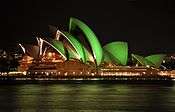
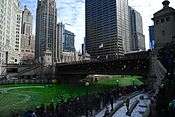

.jpg)



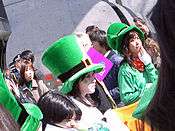






.jpg)
_-_geograph.org.uk_-_1757642.jpg)
